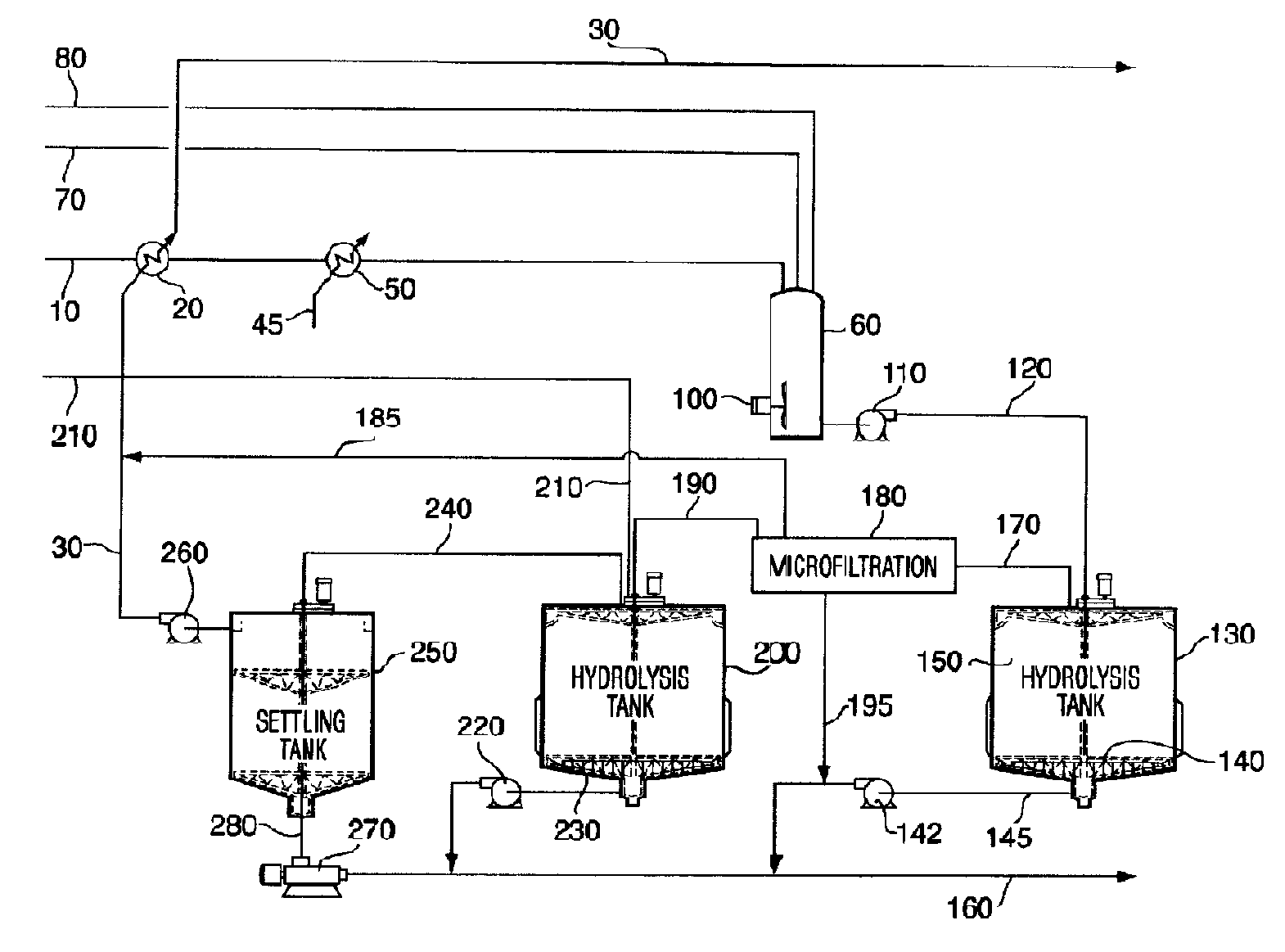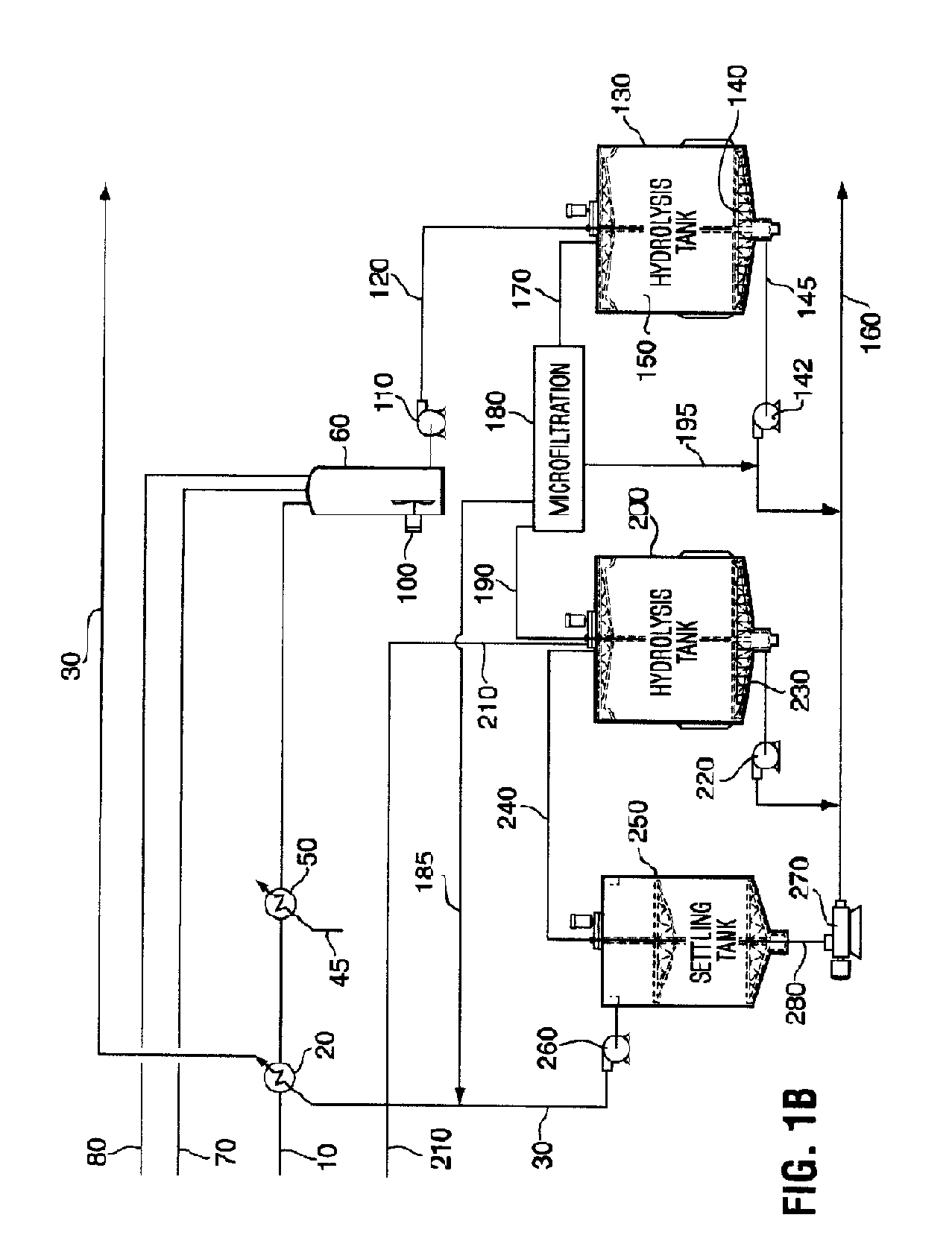Enzyme compositions for the improved enzymatic hydrolysis of cellulose and methods of using same
a technology of cellulose and cellulose hydrolysis, which is applied in the direction of enzymes, biochemical equipment and processes, biofuels, etc., can solve the problems of inability of these novel enzymes to hydrolyze lignocellulosic feedstocks, negative environmental impact of ethanol production from these feedstocks, and limited potential for ethanol production from these sources, etc., to achieve the effect of increasing reaction time, reducing the rate of cellulose hydrolysis, and prolonging contact tim
- Summary
- Abstract
- Description
- Claims
- Application Information
AI Technical Summary
Benefits of technology
Problems solved by technology
Method used
Image
Examples
example 1
Hydrolysis of Pretreated Feedstock with Cellulase Enzymes and β-Glucosidase Containing a CBD in an Upflow Hydrolysis Reactor
[0151]With reference to FIG. 1B, the pretreated feedstock slurry is prepared from 91 t / hr of wheat straw at 20% moisture. The straw is ground to 20 mesh with a hammer mill and cooked with steam at 230° C. and 3314 kg / hr sulfuric acid (93% w / w) diluted in 422,000 kg / hr of water in accordance with the teaching of Foody, U.S. Pat. No. 4,461,648. When exiting the pretreatment reactor, the pretreated lignocellulosic feedstock slurry 10 is cooled using a heat exchanger 20 that exchanges against an aqueous glucose stream 30 or other suitable fluid. The pretreated feedstock slurry 10 is then further cooled to a temperature of between about 45° C. and about 55° C. using a second fluid, for example, cold water 45 at heat exchanger 50. The pretreated feedstock slurry 10 is then pumped into a hydrolysis make-up tank 60, along with an aqueous solution of enzymes 70, which i...
example 2
Hydrolysis of Pretreated Feedstock with Cellulase Enzymes and β-Glucosidase Containing a CBD in an Upflow Hydrolysis Reactor with Continued Hydrolysis
[0154]This example relates to the enzymatic hydrolysis of a pretreated feedstock with cellulase enzymes and β-glucosidase with a CBD, followed by separation of unhydrolyzed fiber solids from the aqueous phase and resuspension of the fiber solids. The re-suspended fiber solids, which contain the bound β-glucosidase enzyme and cellulase enzymes, are hydrolyzed in a second hydrolysis reactor.
[0155]Hydrolysis of pretreated feedstock with cellulase enzymes and β-glucosidase enzyme with a CBD is carried out in an upflow hydrolysis reactor as described in Example 1. However, in this case, the dimensions of the hydrolysis reactor are selected so that the liquid exits the tank after a residence time of about 24 hours with a cellulose conversion of about 55% to produce a partially-hydrolyzed slurry 150. The partially-hydrolyzed slurry 150, which...
example 3
Cellulose Hydrolysis by Enzyme Including β-Glucosidase with Cellulose Binding Domain (CBD)
[0158]This example illustrates the hydrolysis of pretreated cellulose with solids separation and resuspension of the substrate. The performance of the hydrolysis is better with β-glucosidase with a CBD present than without a CBD.
[0159]Pretreated wheat straw was prepared by continuous pretreatment with 0.6% sulfuric acid (w / w) on feedstock, heated to 185° C. with steam for 3 minutes. The pretreated feedstock was washed with an excess of water and vacuum filtered to remove most of the water. The washed feedstock cake contained 30% solids, and the solids contained 51% cellulose, with the balance being composed primarily xylan, lignin and silica.
[0160]Two cellulase enzyme mixtures from Trichoderma submerged culture fermentations were used in this experiment. Both mixtures contained enhanced levels of β-glucosidase to ensure cellobiose did not accumulate during the hydrolysis. The level of β-glucosi...
PUM
| Property | Measurement | Unit |
|---|---|---|
| mean time | aaaaa | aaaaa |
| time | aaaaa | aaaaa |
| residence time | aaaaa | aaaaa |
Abstract
Description
Claims
Application Information
 Login to View More
Login to View More - R&D
- Intellectual Property
- Life Sciences
- Materials
- Tech Scout
- Unparalleled Data Quality
- Higher Quality Content
- 60% Fewer Hallucinations
Browse by: Latest US Patents, China's latest patents, Technical Efficacy Thesaurus, Application Domain, Technology Topic, Popular Technical Reports.
© 2025 PatSnap. All rights reserved.Legal|Privacy policy|Modern Slavery Act Transparency Statement|Sitemap|About US| Contact US: help@patsnap.com



